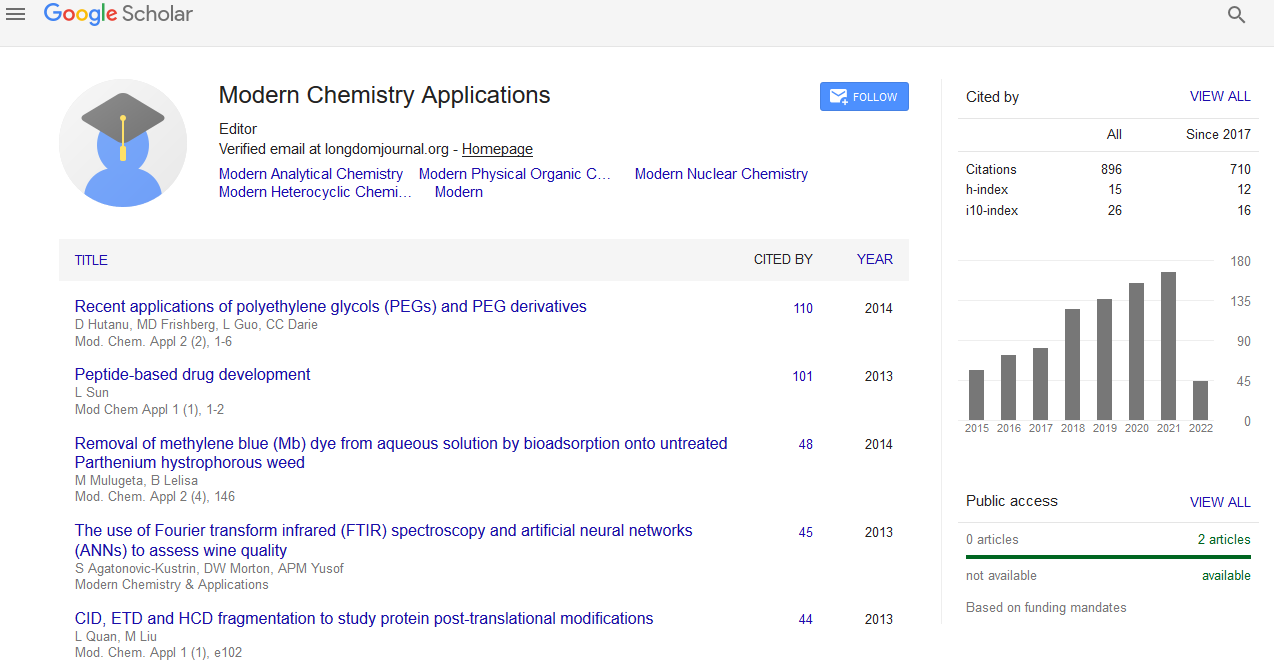Indexed In
- Open J Gate
- JournalTOCs
- RefSeek
- Hamdard University
- EBSCO A-Z
- OCLC- WorldCat
- Scholarsteer
- Publons
- Geneva Foundation for Medical Education and Research
- Google Scholar
Useful Links
Share This Page
Journal Flyer

Open Access Journals
- Agri and Aquaculture
- Biochemistry
- Bioinformatics & Systems Biology
- Business & Management
- Chemistry
- Clinical Sciences
- Engineering
- Food & Nutrition
- General Science
- Genetics & Molecular Biology
- Immunology & Microbiology
- Medical Sciences
- Neuroscience & Psychology
- Nursing & Health Care
- Pharmaceutical Sciences
Multifunctional nanoparticles composed of a mixed ferrite core and a mesoporous silica shell for RGD peptide to target alpha (v) beta (3) integrin in cancer therapy and diagnosis
5th Global Chemistry Congress
September 04-06, 2017 | London, UK
Susel Del Sol Fernandez, Herlys Viltres Cobas, Ricardo Garcia Salcedo, Oscar F Odio Chacon and Edilso Reguera Ruiz
CICATA-IPN, Mexico
IMRE, Cuba
Posters & Accepted Abstracts: Mod Chem Appl
Abstract:
The integrin αvβ3 plays an important role in angiogenesis. It is expressed on tumoral endothelial cells as well as on some tumor cells. RGD peptides are well-known to bind preferentially to the αvβ3 integrin. In this context, targeting tumor cells or tumor vasculature by RGD-based strategies is a promising approach for delivering anticancer drugs or contrast agents for cancer therapy and diagnosis. A key challenge in developing theranostic nano platform is to achieve an optimal pharmacokinetic profile to allow sufficient targeting and to avoid rapid clearance by the reticuloendothelial system (RES). Recently, multifunctional nanostructured materials have been applied to multimodal imaging and simultaneous diagnosis and therapy. In this context, the integration of mesoporous silica with superparamagnetic monodisperse nanocrystals to form uniform core�??shell composite particles has great potential for simultaneous bio imaging and drug delivery. In the present study, mixed ferrite (MnFe2O4) were coated with a mesoporous silica and polyethylene glycol (PEG), making them water soluble and function-extendable for future bio-conjugation with RGD peptide. MnFe2O4@mSiO2-PEG particles were characterized by DRX, TEM, DLS and VMS. Results showed that a spherical, highly-ordered MnFe2O4 nanoparticles with a diameter of around 10 nm, and a narrow size distribution. Dynamic light scattering (DLS) analysis revealed that such MnFe2O4@mSiO2- PEG has a hydrodynamic size of �?20 nm in aqueous solution. The field dependent magnetism of at 300 K shows no hysteresis, demonstrating a superparamagnetic behavior, which is a desirable characteristic for T2 MR contrast agents. The integrated capability of the core�??shell NPs to be used as MR and fluorescence imaging agents, along with their potential use as a drug delivery vehicle, make them a novel candidate for future cancer diagnosis and therapy.
Biography :
Susel Del Sol Fernandez has expertise in the synthesis and characterization of nanomaterials and Medical Physics. She has completed her Master's degree at Center for Research in Applied Science and Advanced Technology (CICATA), Legaria Unit, National Polytechnic Institute, Mexico City, Mexico. Currently, she is a PhD student at CICATA, Legaria Unit. She worked on the synthesis and characterization of iron oxide nanoparticles (magnetite and mixed ferrites) for delivering anticancer drugs or contrast agents for cancer therapy and diagnosis.


